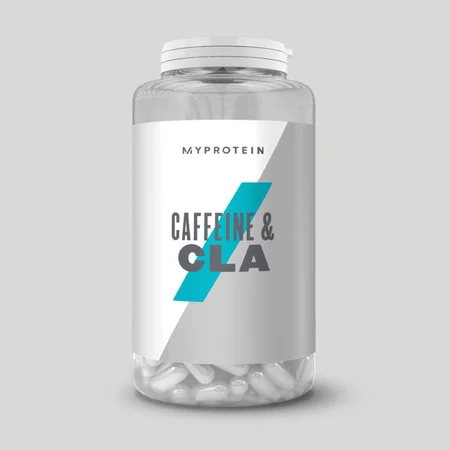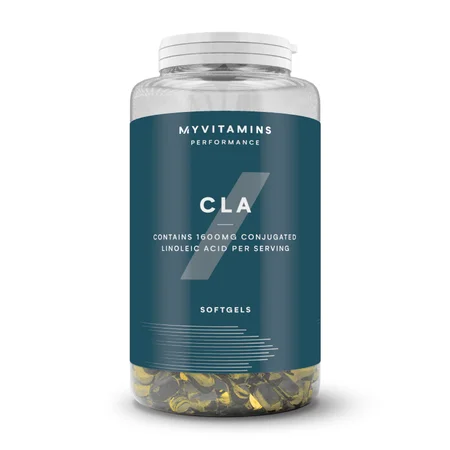Conjugated Linoleic Acid | CLA for Weight Loss, CLA Benefits & Dosage

If you’ve done some googling and found yourself sucked in the quicksand of supplements, then you might be wondering what does CLA do. All these scientific terms can leave you feeling at a loss for what supplements can do for you.
So, we’re here to crack the codes and help you understand what CLA is, how it works, and if it’s the supplement for you.
Whether you’re new to fitness or have been training for years one thing is always true — what you use to fuel your body has a major impact on the results you get. So, what about CLA?
Could it help you lose weight, gain muscle, or improve your performance in the gym? Discover what CLA is, the benefits, if there are any side effects, as well as how to use it to reach your training goals.
In this article you'll find:

What is CLA?
Conjugated linoleic acid (CLA) is a type of essential fatty acid. Now, before you run for the hills at the word “fat”, you should know that not all fats are bad. An essential fat means that the body needs to have this fat to function properly. The body can produce certain fats on its own, but essential fats have to come through the diet.3
In broad terms, there are two main types of essential fats — omega 3 and omega 6. CLA is a sub-category of the omega 6 essential fatty acids — a linoleic polyunsaturated fatty acid. 3
The word conjugated in CLA refers to the arrangement of its single and double bonds (this helps determine the type of fat). CLA is also a naturally occurring trans-fat. Unlike the processed man-made version of trans-fats, CLA is thought to have health benefits associated with it.3
CLA can be found naturally in foods, or in the form of a man-made supplement.
How does CLA work and what does it do?
Some have theorised that CLA can change body composition and facilitate weight loss by altering the metabolism.
The theory behind how CLA works is that it helps the body break down and burn more fat cells, as well as prevents excess fat storage. What’s seen in reality is that this process seems to happen mainly to the fat cells stored inside muscle tissue.
It’s important to note that fat cells inside the muscle don’t seem to affect body fat levels, as this is determined more by subcutaneous fat (fat between the skin and the muscle.) CLA interacts with this process on a cellular level. 7
Most of the benefits of weight loss and changes in metabolism have only been observed in cells (in a test tube) or in animal studies.
These promising results are yet to be seen in most human studies, with weight loss and changes in metabolism being minimal so far.7
More research needs to be carried out to show that CLA positively impacts lean muscle mass in humans. There’s some science showing potential in animal test subjects, though.6
Hyper-triacylglycerolemia (high levels of triglycerides in the blood stream) and elevated plasma cholesterol are suggested as major risk factors for cardiovascular disease. There are two main types of cholesterol that affect heart health. Simply put, there’s HDL (which carries cholesterol away from the heart) and LDL (which carries cholesterol to the heart).1
Generally, if HDL is low, and LDL and fat in the bloodstream are high, then the risk of heart disease goes up. There have been studies that demonstrate anti-sclerotic and improvements in blood lipid profiles in animal models. This discovery led scientists to think that it might be the same for humans. 1
Whilst the majority of the human studies indicate no adverse effects on heart health when supplementing with CLA, they showed no benefit of an improved blood lipid profile. 1
For years, CLA has been thought to positively affect blood glucose levels and insulin sensitivity. This could be of particular interest to the obese and insulin resistant population. In healthy people, there’s a normal insulin “sensitive” response to eating food.1
When someone starts to become insulin resistant, they need more insulin to do the same job, which in turn puts a strain on the pancreas (which can lead to diabetes). 1
To date, there’s no specific scientific evidence that CLA improves insulin sensitivity — so far, the studies showed mixed results.
There was one particular study that showed a small benefit in young sedentary humans, but the study group was small, so more research with a bigger group of test subjects is needed.1
The consensus is that the overall results are inconclusive to date, but so far CLA doesn’t positively affect blood glucose and insulin sensitivity.1
There have been several studies to date that look at what does CLA do for the immune system — so far the results have been highly variable.
When looking at how to make a conclusion based on the science available, a good place to start is to look at what the majority of the studies show. Is there a general trend, and if so is it in favour of an effect or not?
The studies on CLA and its effect on the immune system doesn’t seem to show a particularly strong trend as to whether CLA has a distinct positive effect on the immune system.1

Sources of CLA
Now we've answered what does CLA do, you might be wondering how you can get more CLA through your diet. The most common food that you can find CLA in are meat and dairy.
CLA can be found in:
- Beef
- Lamb
- Chicken
- Pork
- Cow’s milk
- Cottage cheese
- Cheddar cheese
CLA dosage and duration
There’s no general consensus as of yet for how much CLA you should take, at what time, and for how long. The studies show a big difference in dosages from as little as 0.7g/d to as much as 6.8g/d for what does CLA do at these different doses.
The majority of the studies look at CLA usage of 8-12 weeks with a few going beyond that. Perhaps the most common dosage would be around 3g daily. If supplementing, then this would best be taken with meals.
Take home message
So, what does CLA do? Most people buy CLA for its potential weight loss properties. CLA is purported to aid muscle growth, lower cholesterol, improve blood glucose levels and support healthy immune function.
CLA is a dose-dependent supplement and has been used with as little as 0,7g/d up to 6.8g.d. The average use seems to be around 3g/d in supplement form for about 8 to 12 weeks.
The jury is still out on the effectiveness of CLA as a supplement in humans. Perhaps as technology improves and more studies are conducted, what is seen in theory might be observed in a real life setting.

Grant is a sports nutritionist and certified strength coach. He has multiple postgraduate diplomas in nutrition and strength coaching as well as a Master’s degree in Sports and Exercise Nutrition, with a specific focus on protein. Grant has worked in the fitness industry for well over a decade and has helped coach professional athletes and sports teams, as well as the average gym-goer looking to get in the best shape possible. He now spends most of his working time teaching fitness professionals and coaching people remotely.
He’s a big believer in practising what he preaches and has been involved in resistance training and martial arts for over 20 years. In his spare time, Grant enjoys being with his wife and daughter as well as the family dogs and catching up on the latest Netflix series.
Find out more about Grant’s experience here and about his personal training here.
- Benjamin, S., Prakasan, P., Sreedharan, S., Wright, A.-D. G., & Spener, F. (2015). Pros and cons of CLA consumption: an insight from clinical evidences. Nutrition & Metabolism, 12. https://doi.org/10.1186/1743-7075-12-4
- den Hartigh, L. J., Wang, S., Goodspeed, L., Wietecha, T., Houston, B., Omer, M., … Chait, A. (2017). Metabolically distinct weight loss by 10,12 CLA and caloric restriction highlight the importance of subcutaneous white adipose tissue for glucose homeostasis in mice. PLoS ONE, 12(2). https://doi.org/10.1371/journal.pone.0172912
- Eynard, A. R., & Lopez, C. B. (2003). Conjugated linoleic acid (CLA) versus saturated fats/cholesterol: their proportion in fatty and lean meats may affect the risk of developing colon cancer. Lipids in Health and Disease, 2, 6. https://doi.org/10.1186/1476-511X-2-6
- Gonçalves, D. C., Lira, F. S., Carnevali, L. C., Jr, Rosa, J. C., Pimentel, G. D., & Seelaender, M. (2010). Conjugated Linoleic Acid: good or bad nutrient. Diabetology & Metabolic Syndrome, 2, 62. https://doi.org/10.1186/1758-5996-2-62
- Kim, Y., Kim, J., Whang, K.-Y., & Park, Y. (2016). Impact of Conjugated Linoleic Acid (CLA) on Skeletal Muscle Metabolism. Lipids, 51(2), 159–178. https://doi.org/10.1007/s11745-015-4115-8
- Kreider, R. B., Ferreira, M. P., Greenwood, M., Wilson, M., & Almada, A. L. (2002). Effects of conjugated linoleic acid supplementation during resistance training on body composition, bone density, strength, and selected hematological markers. Journal of Strength and Conditioning Research, 16(3), 325–334.
- Lehnen, T. E., da Silva, M. R., Camacho, A., Marcadenti, A., & Lehnen, A. M. (2015). A review on effects of conjugated linoleic fatty acid (CLA) upon body composition and energetic metabolism. Journal of the International Society of Sports Nutrition, 12. https://doi.org/10.1186/s12970-015-0097-4
- Salas-Salvadó, J., Márquez-Sandoval, F., & Bulló, M. (2006). Conjugated linoleic acid intake in humans: a systematic review focusing on its effect on body composition, glucose, and lipid metabolism. Critical Reviews in Food Science and Nutrition, 46(6), 479–488. https://doi.org/10.1080/10408390600723953
- Whigham, L. D., Watras, A. C., & Schoeller, D. A. (2007). Efficacy of conjugated linoleic acid for reducing fat mass: a meta-analysis in humans. The American Journal of Clinical Nutrition, 85(5), 1203–1211. https://doi.org/10.1093/ajcn/85.5.1203










